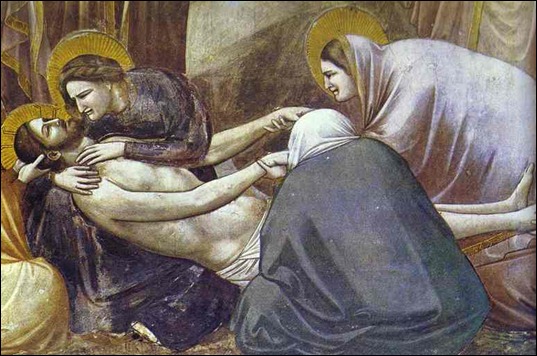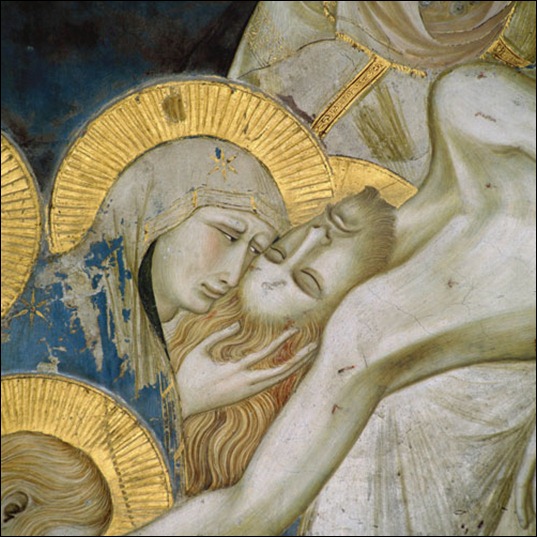Tears of the Virgin Mary Posted by Serena on Apr 18, 2014 in Uncategorized
Pianto della Madonna (Tears of the Virgin Mary) is a dramatic poem written by the Umbrian poet Jacopone da Todi (1236-1306). The poem narrates Jesus’ Passion using the dramatic form of a dialogue between four characters: il nunzio (the herald), la Madonna (the Virgin Mary), il popolo ebraico (the Jewish people), and Gesù (Jesus). Pianto della Madonna, also known as “Donna de Paradiso” from the first line of the poem, was written in volgare umbro (the Umbrian popular language) of the 13th century, six centuries before the standardization of the Italian language.
 |
| Giotto’s powerful ‘Lamentation’ |
The poem is 135 lines long, and I’ve chosen the central part, from line 40 to line 75, which have always been my favourite part due to its powerful imagery: the moving sorrowful words of the Virgin Mary alternate with the crude graphic narration of the herald. Here below is the original text (in bold) followed by the contemporary Italian interpretation and my translation into English. For clarity, the name of the character who speaks each verse is included at the beginning of the contemporary Italian and English translations:
| O figlio, figlio, figlio, figlio, amoroso giglio! Figlio, chi dà consiglio al cor me’ angustïato? |
| Maria: O figlio, figlio, figlio, figlio, amoroso giglio! Figlio, chi dà conforto al mio cuore angosciato? |
| Mary: Oh son, son, son, son, loving lily! Son, who will give comfort to my anguished heart? |
– – – – – – – – – –
| Figlio occhi iocundi, figlio, co’ non respundi? Figlio, perché t’ascundi al petto o’ sì lattato? |
| Figlio dagli occhi che danno gioia, figlio, perché non mi rispondi? Figlio, perché ti nascondi dal petto dove sei stato allattato? |
| Son whose eyes bring joy, son, why don’t you answer me? Son, why are you hiding from the breast that fed you? |
– – – – – – – – – –
| Madonna, ecco la croce, che la gente l’aduce, ove la vera luce déi essere levato. |
| Nunzio: Madonna, ecco la croce che è portata dalla folla, ove Cristo (la vera luce) dovrà essere sollevato. |
| Herald: Mary, here’s the cross brought by crowd, onto which Christ (the true light) will have to be lifted. |
– – – – – – – – – –
| O croce, e que farai? El figlio meo torrai? E que ci aponerai, che no n’à en sé peccato? |
| Maria: Croce, cosa farai? Prenderai mio figlio? E di cosa lo accuserai, visto che non ha commesso alcun peccato? |
| Mary: Oh cross, what will you do? Will you take my son? And what will you accuse him of, since he hasn’t committed any sins? |
– – – – – – – – – –
 |
| Pietro Lorenzetti: ‘Compianto’ |
| Soccurri, plena de doglia, cà ’l tuo figliol se spoglia; la gente par che voglia che sia martirizzato |
| Nunzio: Soccorrilo, o tu che sei piena di dolore, poiché il tuo figliolo è spogliato; sembra che la folla voglia che sia martirizzato. |
| Herald: Help him, oh you who are full of sorrow, because your son is undressed; it seems that the crowd wants for him to be martyrized. |
– – – – – – – – – –
| Se i tollit’el vestire, lassatelme vedere, com’en crudel firire tutto l’ò ensanguenato. |
| Maria: Se gli togliete i vestiti, lasciatemi vedere come lo hanno tutto insanguinato infliggendogli crudeli ferite. |
| Mary: If you take his clothes away, let me see how they bathed him in blood by inflicting cruel wounds on him. |
– – – – – – – – – –
| Donna, la man li è presa, ennella croc’è stesa; con un bollon l’ò fesa, tanto lo ’n cci ò ficcato. |
| Nunzio: Donna, gli hanno preso una mano e l’hanno stesa sulla croce; l’hanno spaccata con un chiodo, tanto gliel’hanno conficcato. |
| Herald: My Lady, they’ve taken one of his hands and laid it on the cross; they’ve broken it with a nail, so deeply they’ve planted it in. |
– – – – – – – – – –
| L’altra mano se prende, ennella croce se stende e lo dolor s’accende, ch’è plu multiplicato. |
| Gli prendono l’altra mano e la stendono sulla croce, e il dolore brucia, ancora più accresciuto. |
| They’re taking his other hand and they’re laying it on the cross, and the pain burns, more and more intensely. |
– – – – – – – – – –
| Donna, li pè se prènno e clavellanse al lenno; onne iontur’ aprenno, tutto l’ò sdenodato. |
| Donna, gli prendono i piedi e li inchiodano al legno; aprendogli ogni giuntura, lo hanno tutto slogato. |
| My Lady, they’re taking his feet and nailing them to the wood; opening his every joint, they’ve completely dislocated him. |
– – – – – – – – – –
If you’re interested, you can read the whole poem (without the English translation) HERE

Build vocabulary, practice pronunciation, and more with Transparent Language Online. Available anytime, anywhere, on any device.




Leave a comment: